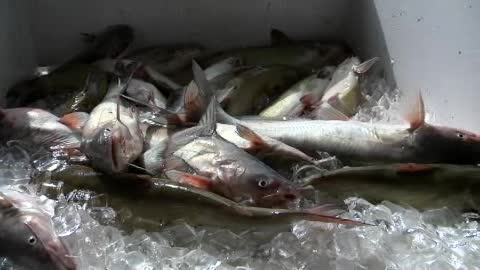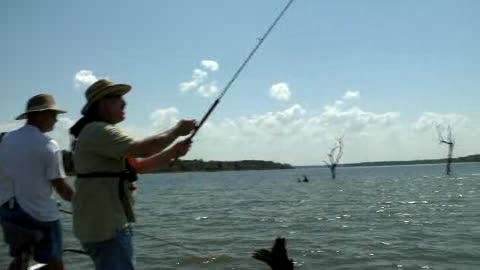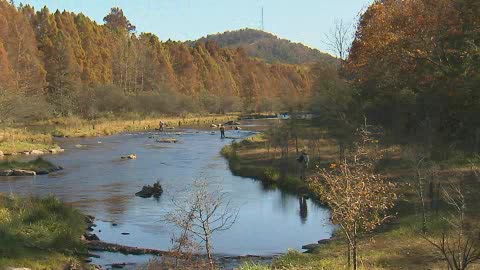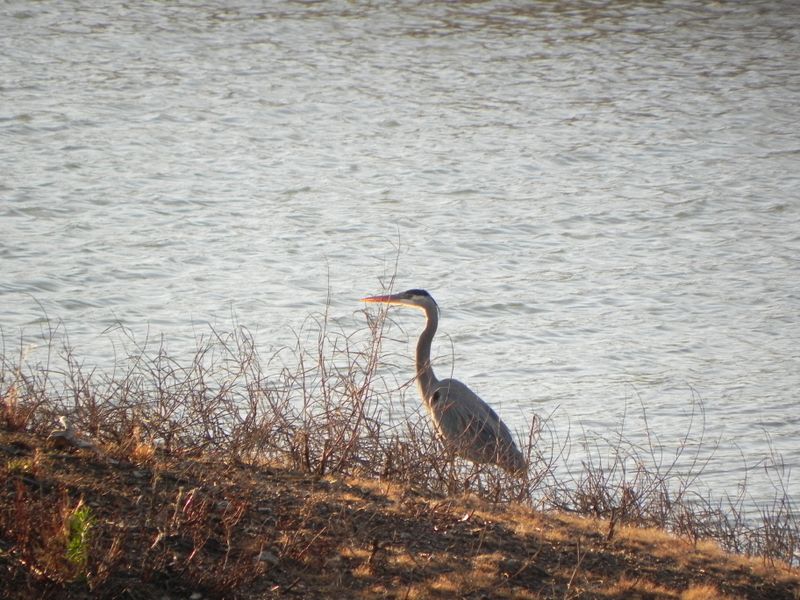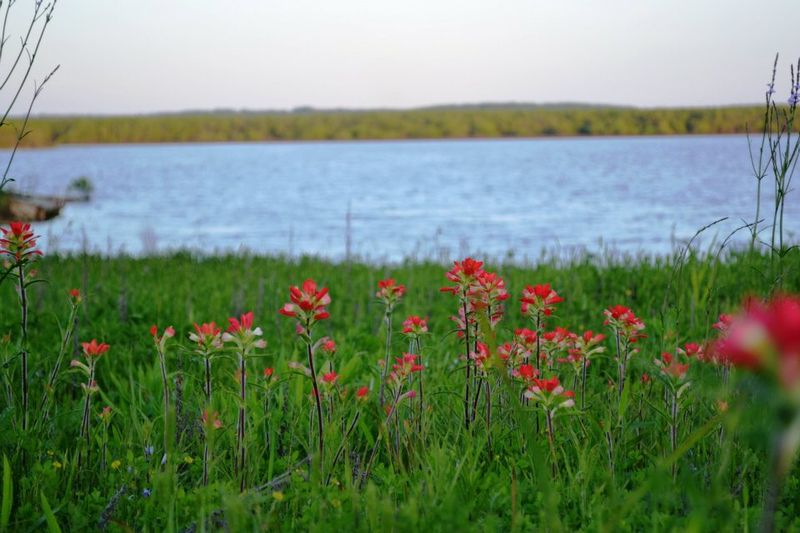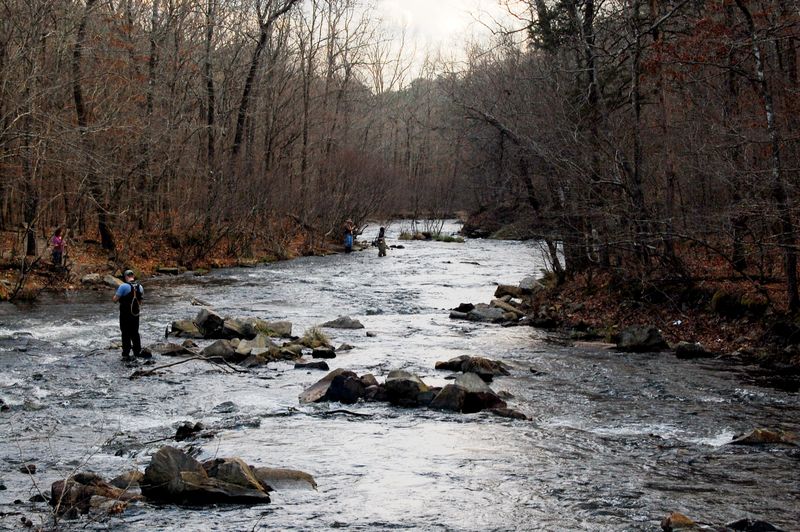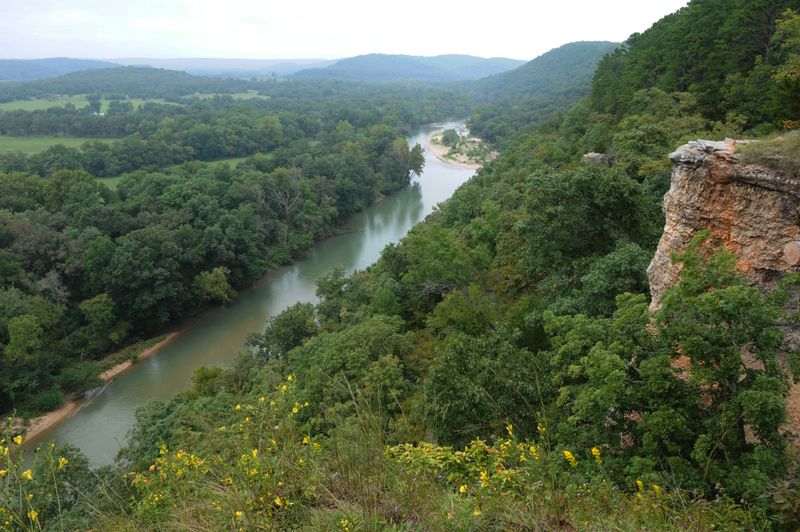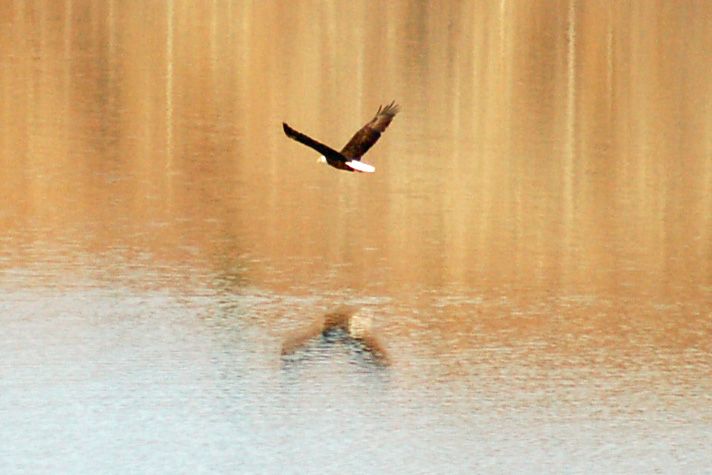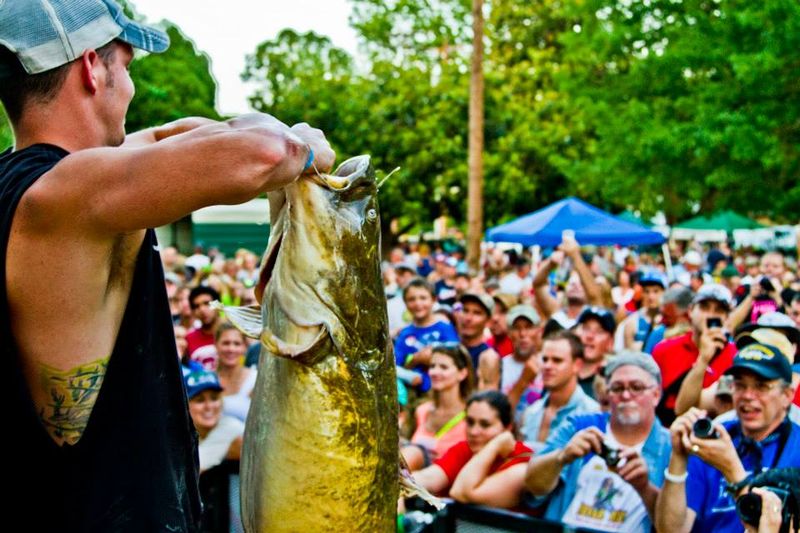Check lake and fishing conditions, or peruse the Oklahoma Fishing Guide for day and size limits, along with general information on regulations and fishing areas. To purchase a fishing license, click here.
Bass
You’ll find a wide variety of bass across the state, but the most common are smallmouth, largemouth, striped and hybrids. Smallmouth bass appear naturally in many eastern Oklahoma streams and tributaries, and they are especially plentiful in shallow waters around the Ouachita National Forest. Smallmouth fishing is strong in places like Lake Tenkiller and the Arrowhead Area at Lake Eufaula State Park, but largemouth varieties are more abundant in the western half of the state.
If it’s striped bass you’re after, try your luck at Lake Texoma in south-central Oklahoma’s Chickasaw Country. This 89,000-acre lake is home to some of the best striper fishing in the world, but you’ll find plenty of other trophy-sized species here as well. Striped bass hybrids are also abundant here, but you may want to go off the beaten path to Great Salt Plains Lake in the northwestern part of the state, where you can fish in Oklahoma’s only saltwater lake and take in the unique beauty of Salt Plains State Park for a one-of-a-kind angling experience.
Trout
The Oklahoma Department of Wildlife Conservation has introduced two species of trout to the state’s waters: brown trout and rainbow trout. Brown trout are identified by the orange and red spots on their sides, while rainbow trout are known for their iridescent coloring and black spots on the tail and fin. Whichever one you’ve got your eye on, these rare fish are fun to catch and great to eat.
Brown trout are less abundant than their more colorful cousins, as they are periodically stocked in just two locations: the Lower Mountain Fork River below Broken Bow Lake and the Illinois River below Lake Tenkiller. Rainbow trout, on the other hand, are stocked approximately every two weeks at all of Oklahoma’s trout areas. You’ll find these beauties across the state, from Lake Wayne Wallace at Robbers Cave State Park in eastern Oklahoma to Lake Carl Etling at Black Mesa State Park & Nature Preserve in the panhandle.
Catfish
Few species are as connected to Oklahoma’s fishing and dining culture as the humble catfish. You’ll find channel, blue and flathead varieties in lakes, rivers and ponds across the state. Channel catfish are the most abundant, populating waters from Lake Wister in eastern Oklahoma to the Fort Cobb Reservoir in the southwest. You’ll find plenty of blue catfish in the lakes of northeastern Oklahoma’s Green Country, while flatheads are common in most large impoundments and streams across the state.
There are plenty of ways to catch a catfish—from trot lining to old-fashioned rod and reel—but noodling, or hand-fishing, is the preferred method for adventurous anglers in the Sooner State. Fans of this distinctly Oklahoman method of take won’t want to miss the annual Okie Noodling Tournament in Paul’s Valley, where you can marvel at hand-caught monster catfish up close. If noodling’s not quite your thing, you can still celebrate this freshwater favorite at one of Oklahoma’s top-notch catfish restaurants.
Sunfish
Far and away the most common fish in Oklahoma, sunfish can be found in just about any lake across the state. Whether you’re looking for bluegill, redear or green sunfish, this species is extraordinarily plentiful and almost always willing to bite. Their abundance and catchability make sunfish the perfect variety for introducing a youngster to the sport of fishing, so be sure to grab your rod and reel during your next family trip to one of Oklahoma’s kid-friendly state parks.
May and June are the most active months for spawning sunfish. Whether you’re trying your luck at McGee Creek Reservoir, Fort Gibson Lake or any of the waters at Beavers Bend State Park, late spring is the best time to cast your line for this plentiful species. While sunfish are frequently eager to bite, you’ll increase your chances by using worms along shallow shorelines in areas protected from wind and boat traffic.
Walleye
Since its original introduction in Canton Lake and Lake Tenkiller in the early 1950s, you can now find walleye in most major lakes across Oklahoma. A member of the perch family, walleye can be identified by their spiny dorsal fin which—unlike its sauger and saugeye cousins—is unmarked by spots or stripes. While walleye are stocked statewide, this species is most plentiful in the lakes of Oklahoma’s southwestern Great Plains Country, where you can enjoy the great outdoors among ancient granite mountains and stunning short-grass prairie.
The enclosed fishing docks at Foss State Park are a great place to cast your line for walleye. This unique oasis is home to the 8,800-surface acre Foss Lake, which also includes big populations of sandbass, striped bass hybrids and catfish. Tom Steed Lake is another great spot to fish for walleye, where you can enjoy a day on the water surrounded by the gorgeous Great Plains State Park. Be sure to stop by Tom Steed Bait Shop for burgers and beer after a long day of fishing.
Paddlefish
Grand Lake O’ the Cherokees may be known for its trophy bass fishing—having been home to the Bassmaster Classic twice in less than a decade—but the Grand Lake Area is also gaining notoriety for a much rarer species: the paddlefish. Also known as spoonbills, these massive, primitive fish are one of the largest freshwater species in the United States. This unique species is well adapted to living in rivers and lakes, and you’ll find them most frequently in deeper, low-current areas like side channels, backwater lakes and tailwaters below dams.
Twin Bridges Area at Grand Lake State Park is near the Oklahoma Department of Wildlife Conservation's Paddlefish Research & Processing Center, which collects important biological data, processes paddlefish meat for anglers and salvages paddlefish eggs. Those interested in this unique species will want to contact the department for more information during the research center’s open period in the spring.
Sauger & Saugeye
Sauger is a unique species of the perch family, found primarily in the clear rivers of eastern Oklahoma. Anglers are likely to have the best luck fishing the Poteau, Illinois, Red and Neosho river systems, or—more rarely—in the tailwaters below Lake Texoma. This species’ relative lack of abundance makes it a rare and rewarding treat for anglers looking for a challenge.
Saugeye are produced in state fish hatcheries through a crossing of walleye and sauger. This hybrid can be distinguished by the spots and bars in the webbing of its spiny dorsal fin. A more recent addition to the Sooner State, both saugeye and sauger are considered by many connoisseurs to be among the best-tasting freshwater fish in the United States, making it the perfect species for those looking to cook their catch.
Be sure to check out our overview of Oklahoma's top lakes, along with many other resources for more information about fishing in Okahoma.











